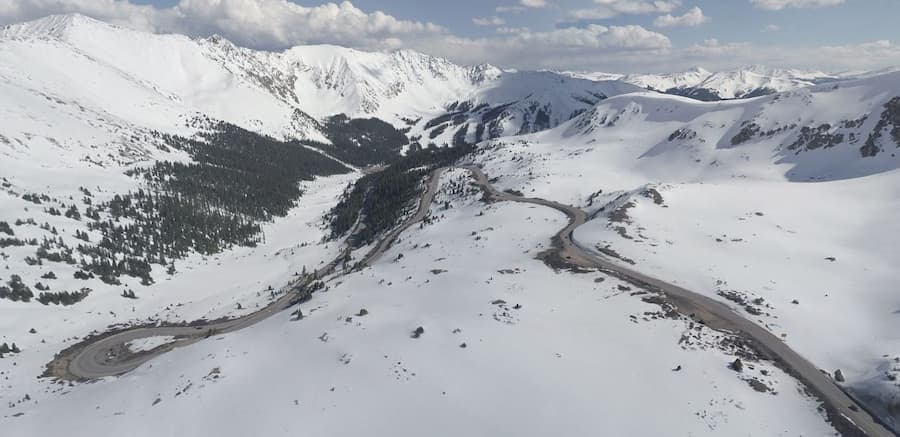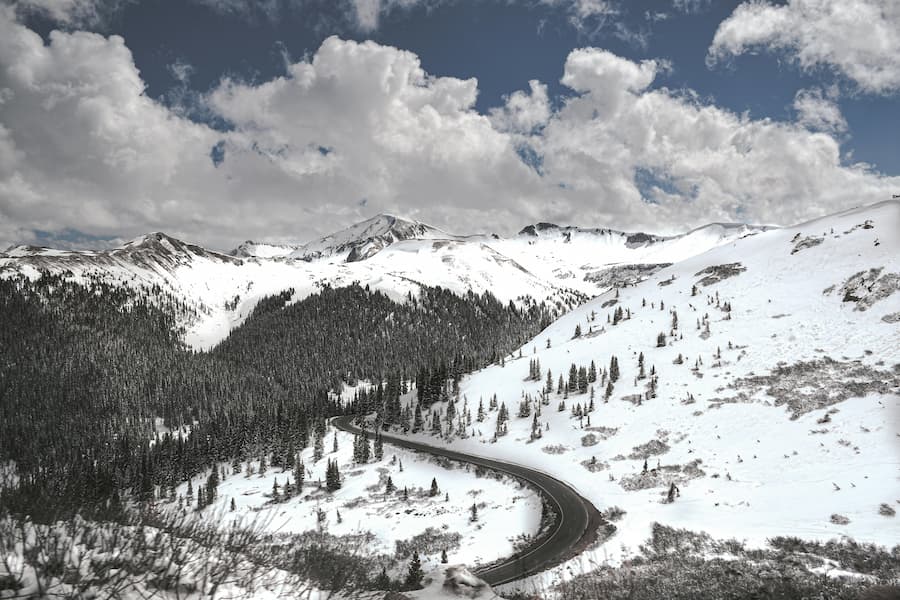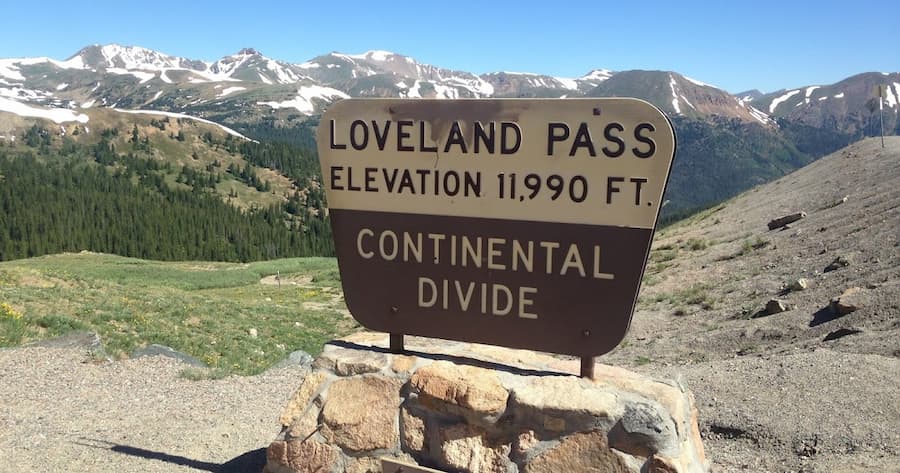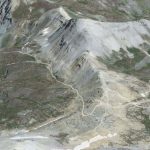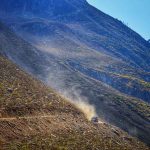Nestled in the heart of the Rocky Mountains, Loveland Pass is a breathtaking mountain pass that offers an exhilarating journey through some of Colorado’s most stunning scenery. Situated along the Continental Divide, Loveland Pass is a popular destination for outdoor enthusiasts, photographers, and adventurers seeking a taste of high-altitude beauty. Loveland Pass is located in the Arapaho and Roosevelt National Forests of Colorado, USA. It sits at an elevation of 11,990 feet (3,655 meters) above sea level, making it one of the highest mountain passes accessible by a paved road in North America. The pass spans approximately 12 miles (19 kilometers) along the Continental Divide, connecting Clear Creek County and Summit County.
- Location: Colorado, USA
- Range: Front Range
- Elevation: 11,990 feet (3,655 meters)
- Lenght: 12 miles (19 kilometers)
- Connects: Clear Creek County and Summit County

Satellite image, Loveland Pass
What to Do and See Around
The area surrounding Loveland Pass offers a wealth of outdoor activities and attractions for visitors to enjoy year-round:
- Scenic Drives: The drive along Loveland Pass offers stunning panoramic views of rugged mountain peaks, alpine meadows, and crystal-clear mountain lakes. The scenic overlooks provide excellent photo opportunities and a chance to soak in the natural beauty of the Rocky Mountains.
- Hiking and Backpacking: Numerous hiking trails wind through the surrounding wilderness, ranging from easy strolls to challenging treks. Popular trails include the Herman Gulch Trail, which leads to a picturesque alpine lake, and the Continental Divide Trail, which traverses the length of the pass.
- Backcountry Skiing and Snowboarding: Loveland Ski Area is located north west of the pass, and Arapahoe Basin is on the south/southeast side. The pass itself is a popular destination for backcountry skiers. During the winter months, Loveland Pass becomes a mecca for backcountry skiing and snowboarding enthusiasts. Its steep slopes and deep powder attract thrill-seekers from near and far, offering an adrenaline-pumping experience amid stunning mountain scenery.
- Wildlife Viewing: Keep an eye out for native wildlife such as bighorn sheep, mountain goats, elk, and marmots, which are commonly spotted in the area. Birdwatchers can also catch glimpses of various bird species, including eagles and hawks soaring high above the mountain peaks.
- Photography: Whether you’re an amateur photographer or a seasoned pro, Loveland Pass provides endless opportunities for capturing stunning landscape shots. From sunrise to sunset, the changing light creates dramatic vistas that are sure to impress.
Driving Experience
Driving along Loveland Pass can be both exhilarating and challenging, especially for those unaccustomed to mountain roads. The narrow, winding road features steep grades and sharp curves, requiring careful attention and cautious driving. During the winter months, the pass can experience heavy snowfall and icy conditions, making chains or four-wheel drive vehicles necessary for safe travel.
Despite its challenges, the drive along Loveland Pass is incredibly rewarding, offering unparalleled views of the surrounding mountain peaks and valleys. Travelers are treated to a true taste of Colorado’s rugged beauty, with every twist and turn revealing another breathtaking vista.
History
Loveland Pass derives its name from William A.H. Loveland, an influential figure in the development of Colorado’s transportation infrastructure during the late 19th century. William A.H. Loveland was a visionary businessman and politician who played a pivotal role in the expansion of railroads and highways across the state.
The pass was constructed in the late 19th century as part of efforts to establish a reliable transportation route through the Rocky Mountains. Its construction was crucial for connecting the mining towns of Clear Creek County with other regions of Colorado and beyond. The exact year of construction is not readily available, but it occurred during the late 1800s when Colorado’s mining industry was booming, and there was a pressing need for improved transportation links. Loveland Pass quickly became an essential thoroughfare, facilitating the movement of people, goods, and resources across the rugged terrain of the Rocky Mountains.
Over the years, Loveland Pass has undergone upgrades and improvements to accommodate modern vehicles and increasing traffic. However, it still retains its historic charm and significance as a vital transportation corridor in Colorado.
Today, Loveland Pass not only serves as a crucial link between Clear Creek County and Summit County but also stands as a popular destination for outdoor enthusiasts, offering spectacular vistas, hiking trails, and backcountry skiing opportunities amid the majestic scenery of the Rocky Mountains. It remains a tribute to the vision and determination of William A.H. Loveland and a testament to Colorado’s rich history of transportation development.

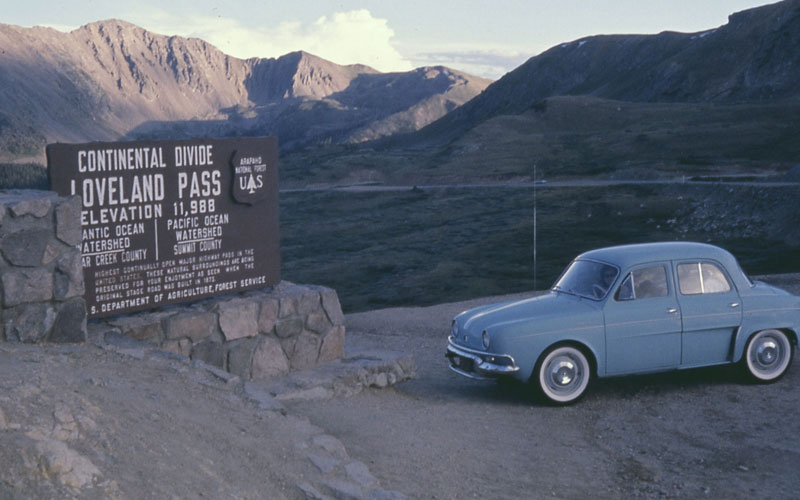
Loveland Pass in Google Maps
Featured Picture by William Busby


